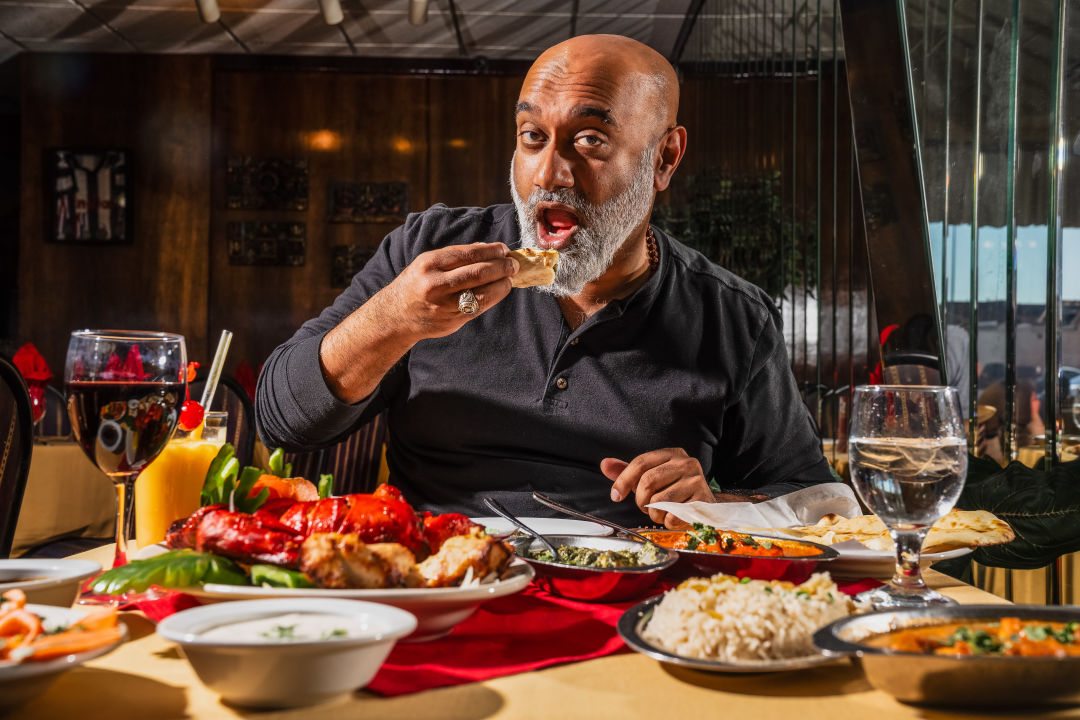How Houston Became America’s Indian Food Capital

Biju Sukumaran reminisces about his Houston childhood while enjoying the India's Restaurant buffet.
Image: Brian Kennedy
Growing up in Houston in the ’80s, I found Indian restaurants were few and far between in the city, but that’s all changed. When I moved back in 2018 after decades away, just a cursory glance at delivery options was overwhelming.
It’s not just staples like North Indian food—naan and rich curries like chicken tikka and saag paneer—but humble cooking you’d never think to see outside of a home.
Flying Idlis in downtown Houston is probably the most surprising and in-your-face representation of this, focusing on South Indian comfort food. Idlis are saucer-shaped cakes of steamed fermented rice and lentil flour dough, often dipped in the sour and fiery stew called sambar. And Flying Idlis is not the only spot serving food from the south. Restaurants have popped up all over Houston in the past two decades dishing out dosas, simple lentil and rice crepes served with chutneys or stuffed with masala vegetables—the food I still get excited for my mother to cook on a lazy Saturday when I visit my parents in the burbs.
During the pandemic, takeout was king, and interesting takes on delivery, like Shef, popped up. A combo of “she” and “chef,” the company aims to honor mothers everywhere who prepare meals daily for their families. When I ordered from the platform, I got to try home-cooked Tamil vegetarian food from a woman who goes by Swathy G.: classics like idli and sambar, all familiar from my own Southern Indian roots in Kerala, all different and incredibly niche.

India's Restaurant has been a Houston classic since the 1980s.
Image: Brian Kennedy
When my family left central Houston for the suburbs in 1988, Indian food was strange, something to be made fun of. The one time my mom packed an Indian lunch was never repeated: it looked weird and smelled worse according to my peers, a common story among many first-generation kids. While historically unsurprising, I’ve always found it interesting to see how embraced Indian food is among Houston’s British population. I’d always hear UK accents amidst the sea of brown faces, eager to get a taste of home. And that pub-style cuisine is still celebrated at places like the Red Lion British Pub and London Sizzler.
But fusion has been the name of the game in Houston since immigrants started arriving here. There’s Tex-Indian like the paratha tacos at Twisted Turban and Rollin’ Phatties, naan pizzas (rest in peace, Bombay Pizza Company), and butter chicken kolaches thanks to Pondicheri.
There’s even old-school fusion like Monk’s, an Indo-Chinese restaurant, celebrating the cuisine of Chinese immigrants to India. Over the years, Houston has offered Indian–South African fusion at the now-closed Peli Peli Kitchen, Indo-Portuguese at Da Gama, as well as Indo-Caribbean and Malaysian food, showcasing the many pathways the diaspora has flowed throughout the world.
From the suburbs, a hike to town for food was like a pilgrimage, a connection to a past left behind by my parents for a better life, yet a culture I only glimpsed in brief flashes. In the early days it was humble, like a stop at the old Bombay Palace or Raja Sweets, one of the oldest establishments in what would later become the Mahatma Gandhi District.

India's Restaurant offers menu options as diverse as the country itself.
Image: Brian Kennedy
Counter service gave way to midrange sit-down eateries. Now, we have super high-end restaurants like Kiran’s in Upper Kirby, Amrina in The Woodlands, and Musaafer in the Galleria, where chef Mayank Istwal showcases the regionality of India inspired by a 100-day journey he undertook to learn about the subcontinent.
I don’t have to go to the subcontinent to learn about regionality—I have Houston. At Maharaja Bhog, I get to sample Western Indian food on an unlimited thali plate. I can visit Momo House and try Nepalese, Aga’s for Indo-Pak, or sample a never-ending variation of biryanis strewn across town.
Driving across Houston, I notice so many new places opening. I have yet to sample Sri Lankan fusion, but it’s there. After all, Mahatma Gandhi isn’t the only Little India: there’s Missouri City and Sugar Land, which now house a sizable portion of the Houston area’s Desi population.

Writer Biju Sukumaran found comfort in rediscovering India's Restaurant.
Image: Brian Kennedy
On one recent drive, I happened across a small restaurant on Richmond that seemed awfully familiar. It was India’s, established back in 1980, the year my family moved to Houston, perhaps the first Indian restaurant I ever went to. I thought it had closed, but when I entered it was like walking into a memory. The decorations I had gaped at as a little kid, the huge mirrors, even a lot of the waitstaff looked suspiciously familiar.
Prasad is the one food that’s hardest to access as an outsider. It’s the sacred offering to the gods in Hinduism, blessed by heaven, eaten later as a continuation of that grace. It’s always changing by region or ceremony. It’s not restaurant food, and it’s not always particularly good. But it’s yours.
I sat down to the India’s buffet for the first time in about 30 years. It’s still the best Indian buffet in town, but maybe I’m biased. After all, it’s my place. Houston has been on a long journey of diversifying, both inside and out. My suburban bullies became “ethnic” food lovers. Now I can see Indian influences from chain taco joints to supermarkets.
But after all that time away, after all that struggle and change, sometimes it’s just good to come home.




